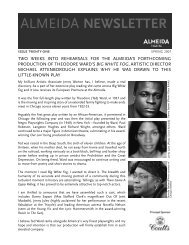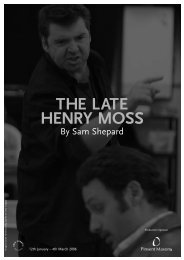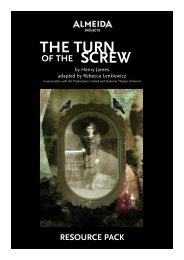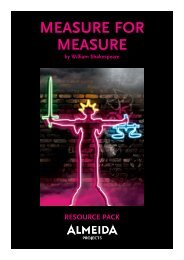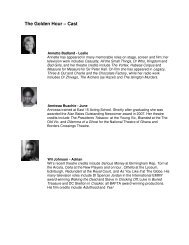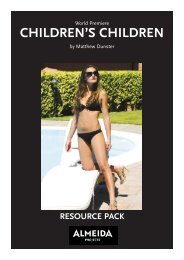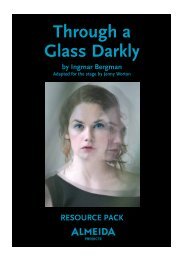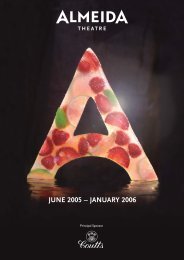KNOT HEART - Almeida Theatre
KNOT HEART - Almeida Theatre
KNOT HEART - Almeida Theatre
- No tags were found...
You also want an ePaper? Increase the reach of your titles
YUMPU automatically turns print PDFs into web optimized ePapers that Google loves.
DesignThe Knot of the Heart is designed by Peter McKintosh.The Knot of the Heart Model BoxThe Knot of the Heart places immediate challenges for the <strong>Almeida</strong> <strong>Theatre</strong> stage because of itsmultiple locations. The play takes place in a variety of locations, of vastly different characteristics: fromthe family home (a Georgian townhouse in Islington’s Gibson Square), to City Roads Drug CrisisIntervention Centre, to hospitals and clinics and ultimately to the top of Table Mountain. With the<strong>Almeida</strong>’s lack of wing space and flying space (sides and above stage respectively), the best solution isto use a revolve – a mechanism that rotates the stage enabling multiple locations to be presented inone set structure.The revolve is a circular shape and on top of that sits the set, divided into three distinct areas, each adifferent size. The largest takes up roughly half the stage, a semi-circle, the second and third divide asemi-circle into smaller and larger sections. These create different sized rooms which fit both thelocation and the emotional action of the play accordingly. So, for example, the play opens in the large,open playing space, which is then the garden at the Gibson Square house. However, in the followingtwo scenes, as Lucy’s drug habit descends into hard addiction, we move to smaller and smallerspaces, echoing the closing-in of Lucy’s world. Similarly, the treatment room at City Roads is madefrom the smallest space, and Table Mountain returns to the expansive half-stage layout.To enable the plausibility of multiple locations to be at its optimum, the construction and design of thewalls of the set have been kept very simple, with clean lines. However within this, selected realisticprops are carefully chosen to indicate location: garden chairs in the first scene, a hospital bed, thefunctional chairs of a doctor’s clinic or the floor cushions of an Islington townhouse. Because the playis set in the present day, we can pick up on the location easily with only a minimum of details. Thisbrings to mind the dual impression that minimalist decoration can bring, depending on context: it canbe an indicator of both artfully sparse luxury but also cold clinical sparseness. As the revolve turns,stage management will re-set a scene to create a different environment, ready for the next scene.The bare back wall of the <strong>Almeida</strong> is visible but covered in ivy; this gives the impression of the outsidewall of an old house, suggesting a wealthy sort of property, common in Islington, bringing back thevery local focus. However, the ivy itself may symbolise the enveloping power of addiction over thefamily’s life – ivy as a fast-growing plant that can cause serious structural damage particularly to wallswith existing weakness, and a plant that draws life and nutrients from other organisms growing nearby.17 Resource Pack: The Knot of the Heart



